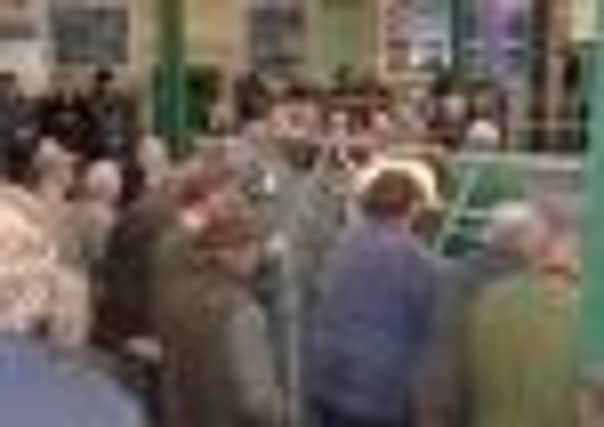Market’s century at heart of town


Livestock markets have long been the bedrock of the cattle and sheep world. It is largely accepted that they set the price by which stock is sold elsewhere too, whether trading privately or supplying straight to abattoirs. Without them livestock producers would find life far more difficult.
That message was rammed home to farmers during the Foot and Mouth crisis of 2001 when livestock could not be moved in the same way. There were many instances of purchasers taking advantage of livestock markets being in limbo, who slashed the price they paid knowing that farmers had nowhere else to go. It was a timely reminder of the benefit of competition around a sale ring.
Advertisement
Hide AdAdvertisement
Hide AdDriffield and Ripon’s livestock markets never reopened after the crisis. Stokesley, Bingley, Otley Bridge End, Pannal, Wetherby, Masham, Penistone, Doncaster and Seamer have all become casualties in the past three decades, but one livestock market is celebrating 100 years of trade this year.
Applegarth Mart, better known as Northallerton Livestock Market and with a business name of Northallerton Auctions, started life over a century ago in 1907, tucked away just 100 yards off the High Street. It was 1912 when the mart itself came into existence, leading to the way it is run today. Previously it had been known as John Todd’s Northallerton Storestock Market.
Back in those days, prior to the outbreak of the First World War, Northallerton had three livestock markets. Applegarth proved somewhat luckier than Malpas Livestock Market situated just across the road. During the Second World War its sales ring had a bomb dropped on it. The other livestock market was next to the railway station.
Brian Weighell is the company secretary and started at Applegarth in 1974 when he left school. His family farmed at Castlehills Farm, Romanby, and he’s seen all of the ups and downs of the livestock market trade.
Advertisement
Hide AdAdvertisement
Hide Ad“We’re doing all right at the moment, in fact it’s been a pretty good the last couple of years, but our halcyon period for throughput was in the 1980s. We had 500 fat cattle every Tuesday during that time. Today even the biggest markets don’t get to that number. It was an exceptional period for all livestock markets.
“Things have changed a lot. There isn’t the throughput of stock that there was back then, yet the paperwork is more intense than ever. When I started cattle didn’t have passports and there was very little export of livestock the way there is today.
“We have always had a very loyal customer base but we did lose some of our best customers during the Foot and Mouth crisis.
“We increased the number of other auctions, non-farming related, and the income from other areas meant that we didn’t have to lay anyone off. The really hard part was getting them back but we have recovered.”
Advertisement
Hide AdAdvertisement
Hide AdWith the recent news that planners have now ensured that another North Yorkshire town, Malton, will lose its town centre livestock market in the near future, is the writing now on the wall for Northallerton?
Brian’s not convinced that the call for Applegarth to pack up and move to an out-of-town location would be in the town’s or the mart’s best interests.
“We’re one of the few remaining livestock markets situated in the centre of a town. There have been talks over a move both in recent times and a few years ago when there was much talk and speculation of getting together with Thirsk but unless it’s right for us there’s no point giving up what is presently a very valuable site.
“We have two main livestock days, Tuesday and Wednesday. The Wednesday sale is a traditional storestock market and a very social scene when farmers come out of the hills, often bringing their wives who shop in the town. It’s a real boost to the local economy.
Advertisement
Hide AdAdvertisement
Hide Ad“Tuesday is primestock day and typically we have a throughput of around 1200-1300 fat lambs each week. We have some important buyers of quality primestock. Michael Broad, who owns Cleveland Meat Company, is one of our bigger buyers and we have good competition around the sale ring every week.”
Brian points to the introduction of auctioneer Giles Drew last year as a mark of the market’s intent on showing other livestock markets that Northallerton may have been around for a century but it is also fully committed to its future.
“Giles joined us from Worcester Livestock Market in April 2011. At the time it was seen as a brave decision by some, appointing someone so young but it has been fully justified. He’s very keen, very ambitious and very popular. He knows the livestock industry inside out and has injected so much more life into the place.
“He has increased numbers and has attracted livestock sellers back from selling direct rather than coming here. He also knows how to hold on to a good trade and make the most for every farmer’s stock. We see him as the future of the mart.”
Hard at work to boost trade
Advertisement
Hide AdAdvertisement
Hide AdWhile prices at market have been good for the past two years and are being maintained this autumn, auctioneer Giles Drew hasn’t been simply riding the crest of a wave since he moved north. He has been responsible for the setting up of a collection centre at Brompton-by-Sawdon and finding buyers for stock out of the Wolds, East Coast and Vale of York. There are many more ideas that he and the team are constantly working on to maintain and improve their trade.